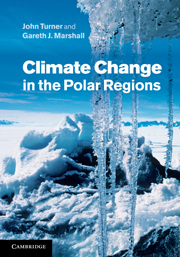Book contents
1 - Introduction
Published online by Cambridge University Press: 07 September 2011
Summary
The environment of the polar regions
The polar regions can be defined in a number of ways, based on geographical, topographic and even political factors. However, geometrically, the Arctic and Antarctic are considered as the areas of the Earth poleward of the Arctic and Antarctic Circles, which are located at latitudes of 66° 33′ 39″ north and south of the Equator (see maps on the end papers). These areas experience at least one day each year when the Sun does not set, and one day when the Sun is always below the horizon. At the poles themselves there is only one sunrise and one sunset each year, which occurs on the equinoxes of 21 September and 21 March. Together the Arctic and Antarctic comprise about 8% of the surface area of the Earth.
The regions of perpetual summer sunlight and winter darkness are present because the Earth is tilted away from the plane of its orbit around the Sun by 23° 27′, resulting in the high latitude areas having periods when they are orientated away from or towards the Sun. The tilt of the Earth's axis changes over long periods of time (millennia), resulting in variations in the latitude of the Arctic and Antarctic Circles. The change in the tilt, along with slow variations in the Earth's orbit about the Sun, alter the amount of solar radiation arriving at different parts of the Earth, which is a major factor in long-term, millennial-scale climate variability.
- Type
- Chapter
- Information
- Climate Change in the Polar Regions , pp. 1 - 15Publisher: Cambridge University PressPrint publication year: 2011
- 1
- Cited by

